电子科技大学:《物理与化学电源基础 Fundamental of Physical and Chemical Power Sources》课程教学资源(课件讲稿,第二部分)Lecture 12 Solid-state Electrolyte in Li-ion Batteries(SSE of LIB)

例 Lecture 13 86 Solid-state Electrolyte in Li-ion Batteries Chen Junsong School of Materials and Energy 2020.04
Solid-state Electrolyte in Li-ion Batteries Chen Junsong School of Materials and Energy 2020.04 Lecture 13
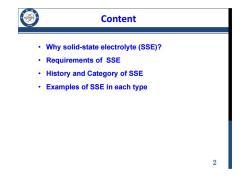
Content 6 Why solid-state electrolyte(SSE)? ·Requirements of SSE History and Category of SSE Examples of SSE in each type 2
2 Content • Why solid-state electrolyte (SSE)? • Requirements of SSE • History and Category of SSE • Examples of SSE in each type

Why SSE? /956 ① The Fire Triangle in a Safety! Li-ion battery O2:To sustain the fire Temperature/heat: Gas release from side Reaching the ignition reactions during point of the fuel charge/discharge OXYGEN IGNITION Thermal runaway due to heat released from side reactions FUEL Fuel:The thing to catch fire The organic liquid electrolyte is combustible High Voltage 3
3 Why SSE? Safety! Fuel: The thing to catch fire The organic liquid electrolyte is combustible O2 : To sustain the fire Gas release from side reactions during charge/discharge Temperature/heat: Reaching the ignition point of the fuel Thermal runaway due to heat released from side reactions The Fire Triangle in a Li-ion battery High Voltage ① ②
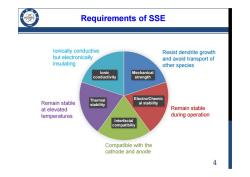
Requirements of SSE 956 lonically conductive Resist dendrite growth but electronically and avoid transport of insulating other species lonic Mechanical conductivity strength Remain stable Thermal Electro/Chemic stability al stability at elevated Remain stable temperatures during operation Interfacial compatibiliy Compatible with the cathode and anode 4
4 Requirements of SSE Mechanical strength Electro/Chemic al stability Interfacial compatibiliy Thermal stability Ionic conductivity Ionically conductive but electronically insulating Resist dendrite growth and avoid transport of other species Remain stable during operation Compatible with the cathode and anode Remain stable at elevated temperatures

History of SSE 2D Na transport identified in Discovery of lithium phosphorus B-Alumina (Na20.11Al2O3) oxynitride(LiPON) High-temperature Inorganic solid electrolyte Aqueous batteries with Na-S batteries Li-ion batteries mediator-ion solid electrolytes 1960s 1980s 1990s 2000s 2010s ·ZEBRA batteries Solid electrolyte Polymer Li-ion batteries Li-air,Li-S and Li-Br,batteries 1.ZEBRA cell:NaCl,Al,Fe,Ni SSE extending its application to powder as active material other lithium-based battery systems 2.Lithium ion transport identified in poly(ethylene oxide)(PEO) 5
5 History of SSE 1960s 2D Na transport identified in b-Alumina (Na2O·11Al2O3 ) 1980s 1990s 2000s 2010s 1. ZEBRA cell: NaCl, Al, Fe, Ni powder as active material 2. Lithium ion transport identified in poly(ethylene oxide) (PEO) Discovery of lithium phosphorus oxynitride (LiPON) SSE extending its application to other lithium-based battery systems
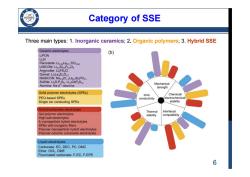
Category of SSE /956 Three main types:1.Inorganic ceramics;2.Organic polymers;3.Hybrid SSE Ceramic electrolytes (b) LiPON Li N Perovskite:Lio4Lao.51TiO24 LISICON:LissSiosPo.sO4 Argyrodite:LiPS CI Garnet:Li-LaZr2O12 NASICON:Na3.3Zr1.Lao.3Si2PO12 Sulfide:Li S-P2Ss.Li0GeP2S12 Mechanical Alumina:Na-B"-alumina strength Solid polymer electrolytes(SPEs) lonic Chemical/ PEO-based SPEs conductivity electrochemical Single ion conducting SPEs stability Hybrid/composite electrolytes Thermal Interfacial Gel polymer electrolytes stability compatibility High-salt electrolytes IL-nanoparticle hybrid electrolytes SPEs with inorganic fillers Polymer-nanoparticle hybrid electrolytes Polymer-ceramic composite electrolytes Liquid electrolytes Carbonate:EC,DEC,PC,DMC Ether:DOL,DME Fluorinated carbonate:F-EC,F-EPE 6
6 Category of SSE Three main types: 1. Inorganic ceramics; 2. Organic polymers; 3. Hybrid SSE
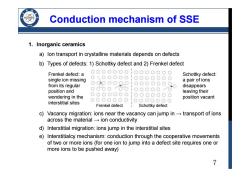
Conduction mechanism of SSE 1.Inorganic ceramics a)lon transport in crystalline materials depends on defects b)Types of defects:1)Schottky defect and 2)Frenkel defect Frenkel defect:a Schottky defect: single ion missing a pair of ions from its regular disappears position and leaving their wondering in the position vacant interstitial sites Frenkel defect Schottky defect c)Vacancy migration:ions near the vacancy can jump in-transport of ions across the materialion conductivity d)Interstitial migration:ions jump in the interstitial sites e)Interstitialcy mechanism:conduction through the cooperative movements of two or more ions (for one ion to jump into a defect site requires one or more ions to be pushed away) 7
7 Conduction mechanism of SSE 1. Inorganic ceramics a) Ion transport in crystalline materials depends on defects b) Types of defects: 1) Schottky defect and 2) Frenkel defect c) Vacancy migration: ions near the vacancy can jump in → transport of ions across the material → ion conductivity d) Interstitial migration: ions jump in the interstitial sites e) Interstitialcy mechanism: conduction through the cooperative movements of two or more ions (for one ion to jump into a defect site requires one or more ions to be pushed away) Frenkel defect Schottky defect Frenkel defect: a single ion missing from its regular position and wondering in the interstitial sites Schottky defect: a pair of ions disappears leaving their position vacant

Conduction mechanism of SSE 2.Organic polymers a)Definition:Solid ionic conductors formed by the dissolution of salts in suitable high molecular weight polymers(solid polymer electrolyte:SPE) b)First developed SPE:poly(ethylene oxide) c)Two conduction theories: Free Volume Theory:As temperature increases,the polymer expands,and creates local empty space,free volume,where the ionic carriers,solvated molecules,or polymer segments can move. The overall movability of the material is determined by the total amount of free volume present in the material. Dynamic Bond Percolation:lons will hop between well-defined ion sites along the disordered polymer,which is undergoing constant motion itself. Li+conduction in PEO:"Lit is coordinated by oxygen on PEO segmental chains.With the breaking and forming of Li-O bonds and continuous segmental rearrangement,long-range lithium transport can be realized"(10.1021/acs.chemrev.9b00268) 8
8 Conduction mechanism of SSE 2. Organic polymers a) Definition: Solid ionic conductors formed by the dissolution of salts in suitable high molecular weight polymers (solid polymer electrolyte: SPE) b) First developed SPE: poly(ethylene oxide) c) Two conduction theories: Free Volume Theory: As temperature increases, the polymer expands, and creates local empty space, free volume, where the ionic carriers, solvated molecules, or polymer segments can move. The overall movability of the material is determined by the total amount of free volume present in the material. Dynamic Bond Percolation: Ions will hop between well-defined ion sites along the disordered polymer, which is undergoing constant motion itself. • Li+ conduction in PEO: “Li+ is coordinated by oxygen on PEO segmental chains. With the breaking and forming of Li−O bonds and continuous segmental rearrangement, long-range lithium transport can be realized” (10.1021/acs.chemrev.9b00268)
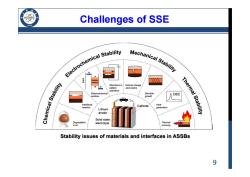
Challenges of SSE Electrochemical stability Mechanical Stabiy Volume change and cracks Chemical Stability operation Dendrite DSC .window growth interfacial Cathode Heat reaction generation Thermal Stability Lithium anode Solid-state Degradation electrolyte 加i runaway Stability issues of materials and interfaces in ASSBs 9
9 Challenges of SSE
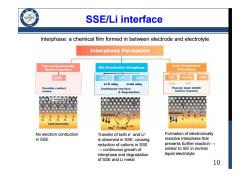
SSE/Li interface 96 Interphase:a chemical film formed in between electrode and electrolyte Interphase Formation Thermodynamically Mix Conductive interphase lonic Conductive Stable Interface Interphase LLZO LATP LLTO LGPS LPS Polymor Li-Ti alloy Li-Ge alloy LIS LIF Possible contact Continuous reaction Passive layer inhibit issues Degradation further reaction nterphas Interphase Solid electrolyte Me三,MeW-r No electron conduction Transfer of both e-and Lit Formation of electronically in SSE is observed in SSE,causing resistive interphase that reduction of cations in SSE prevents further reaction →continuous growth of similar to SEl in normal interphase and degradation liquid electrolyte of SSE and Li metal 10
10 SSE/Li interface Interphase: a chemical film formed in between electrode and electrolyte No electron conduction in SSE Transfer of both e− and Li+ is observed in SSE, causing reduction of cations in SSE → continuous growth of interphase and degradation of SSE and Li metal Formation of electronically resistive interphase that prevents further reaction → similar to SEI in normal liquid electrolyte
按次数下载不扣除下载券;
注册用户24小时内重复下载只扣除一次;
顺序:VIP每日次数-->可用次数-->下载券;
- 电子科技大学:《物理与化学电源基础 Fundamental of Physical and Chemical Power Sources》课程教学资源(课件讲稿,第二部分)Lecture 11 Safety of Li-ion Batteries.pdf
- 电子科技大学:《物理与化学电源基础 Fundamental of Physical and Chemical Power Sources》课程教学资源(课件讲稿,第二部分)Lecture 10 Anode material for LIB(TiO2).pdf
- 电子科技大学:《物理与化学电源基础 Fundamental of Physical and Chemical Power Sources》课程教学资源(课件讲稿,第一部分)Section IV THERMODYNAMICS.pdf
- 电子科技大学:《物理与化学电源基础 Fundamental of Physical and Chemical Power Sources》课程教学资源(课件讲稿,第一部分)Section III Fundamentals of Solar Cell.pdf
- 电子科技大学:《物理与化学电源基础 Fundamental of Physical and Chemical Power Sources》课程教学资源(课件讲稿,第一部分)Section II Nuclear energy(Fundamentals of Fusion Enery).pdf
- 电子科技大学:《物理与化学电源基础 Fundamental of Physical and Chemical Power Sources》课程教学资源(课件讲稿,第一部分)Section I Background and Fuel Cell(陈俊松).pdf
- 电子科技大学:《物理与化学电源基础 Fundamental of Physical and Chemical Power Sources》课程教学资源(课件讲稿,第二部分)Lecture 07 Anode material for LIBs(Lithium).pdf
- 电子科技大学:《物理与化学电源基础 Fundamental of Physical and Chemical Power Sources》课程教学资源(课件讲稿,第二部分)Lecture 06 Anode material for LIBs(Graphite).pdf
- 电子科技大学:《物理与化学电源基础 Fundamental of Physical and Chemical Power Sources》课程教学资源(课件讲稿,第二部分)Lecture 05 Cathode material for LIBs(Li-Mn-O and NCM).pdf
- 电子科技大学:《物理与化学电源基础 Fundamental of Physical and Chemical Power Sources》课程教学资源(课件讲稿,第二部分)Lecture 04 Cathode material for LIBs(LiFePO4).pdf
- 电子科技大学:《物理与化学电源基础 Fundamental of Physical and Chemical Power Sources》课程教学资源(课件讲稿,第二部分)Lecture 03 Lithium-ion Batteries(LiCoO).pdf
- 电子科技大学:《物理与化学电源基础 Fundamental of Physical and Chemical Power Sources》课程教学资源(课件讲稿,第二部分)Lecture 02 Introduction of Lithium Batteries.pdf
- 电子科技大学:《物理与化学电源基础 Fundamental of Physical and Chemical Power Sources》课程教学资源(课件讲稿,第二部分)Lecture 01 Background of Batteries(陈俊松).pdf
- “十四五”可再生能源发展规划(发布稿).pdf
- 《电力系统运行与控制 Power System Operation and Control》课程参考书籍文献:《Operation and Control in Power Systems》PDF电子书(Prof. P. S. R. MURTY).pdf
- 电子科技大学:《电力系统运行与控制 Power System Operation and Control》课程教学资源(课件讲稿)Lecture 10 Power System Security.pdf
- 电子科技大学:《电力系统运行与控制 Power System Operation and Control》课程教学资源(课件讲稿)Lecture 09 Power System Optimal Power Flow.pdf
- 电子科技大学:《电力系统运行与控制 Power System Operation and Control》课程教学资源(课件讲稿)Lecture 08 power system state estimation.pdf
- 电子科技大学:《电力系统运行与控制 Power System Operation and Control》课程教学资源(课件讲稿)Lecture 07 Power System Wide-area Measurement and Control.pdf
- 电子科技大学:《电力系统运行与控制 Power System Operation and Control》课程教学资源(课件讲稿)Lecture 06 Power System Reactive Power and Voltage Control.pdf
- 电子科技大学:《物理与化学电源基础 Fundamental of Physical and Chemical Power Sources》课程教学资源(课件讲稿,第二部分)Lecture 08 Anode Material for LIBs(Silicon).pdf
- 电子科技大学:《物理与化学电源基础 Fundamental of Physical and Chemical Power Sources》课程教学资源(课件讲稿,第二部分)Lecture 09 Anode material for LIBs(Tin).pdf
- 《电力系统自动化》:利用储能系统提升电网电能质量研究综述.pdf
- 《电力电子技术 Power Electronics》:电能质量指标及其算法的研究.pdf
- 深圳市标准化指导性技术文件:分布式光伏发电系统并网接入技术规范(SZDB/Z 227 - 2017)Technical specification for distributed photovoltaic generation system Grid-connected.pdf
- 智能电网:改善低压农网电压质量的分布式光伏——储能系统优化配置方法.pdf
- 国投甘肃小三峡发电有限公司:浅析水电厂AVC控制策略.pdf
- 中国电机工程学会:核能发电专业发展报告(PPT宣讲稿,2019年11月).pdf
- 山西能源学院:《传热学》课程教学资源(电子教案)第一章 绪论 1.1 传热学的研究内容及其在科学技术和工程中的应用 1.2 热能传递的三种基本方式.pdf
- 山西能源学院:《传热学》课程教学资源(电子教案)第二章 稳态热传导 2.1 导热基本定律-傅里叶定律.pdf
- 山西能源学院:《传热学》课程教学资源(电子教案)第二讲 第一章 绪论 1.3 传热过程和传热系数 1.4 传热学的发展简史和研究方法.pdf
- 山西能源学院:《传热学》课程教学资源(电子教案)第二章 稳态热传导 2.2 导热问题的数学描写 2.3 典型一维导热问题的分析解-通过平壁的导热.pdf
- 山西能源学院:《传热学》课程教学资源(电子教案)第二章 稳态热传导 2.3 典型一维导热问题的分析解-通过圆筒壁的导热 2.4 通过肋片的导热.pdf
- 山西能源学院:《传热学》课程教学资源(电子教案)第三章 非稳态热传导 3.1 非稳态导热的基本概念.pdf
- 山西能源学院:《传热学》课程教学资源(电子教案)第三章 非稳态热传导 3.2 零维问题的分析法-集中参数法.pdf
- 山西能源学院:《传热学》课程教学资源(电子教案)第四章 热传导问题的数值解法 4.1 导热问题数值求解的基本思想 4.2 内节点离散方程的建立方法.pdf
- 山西能源学院:《传热学》课程教学资源(电子教案)第三章 非稳态热传导 3.3 典型一维非稳态导热的分析解.pdf
- 山西能源学院:《传热学》课程教学资源(电子教案)第四章 热传导问题的数值解法 4.3 边界节点离散方程的建立及代数方程的求解.pdf
- 山西能源学院:《传热学》课程教学资源(电子教案)第四章 热传导问题的数值解法 4.4 非稳态导热问题的数值解法.pdf
- 山西能源学院:《传热学》课程教学资源(电子教案)第五章 对流传热的理论基础 5.1 对流传热概说 5.2 对流传热问题的数学描写.pdf
